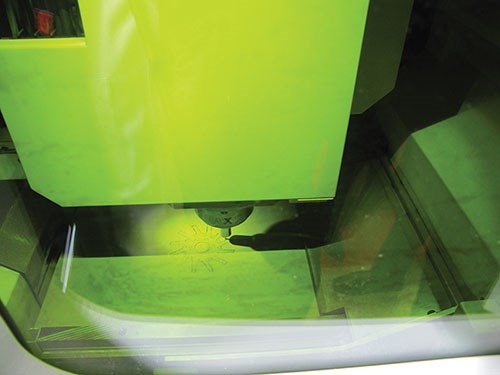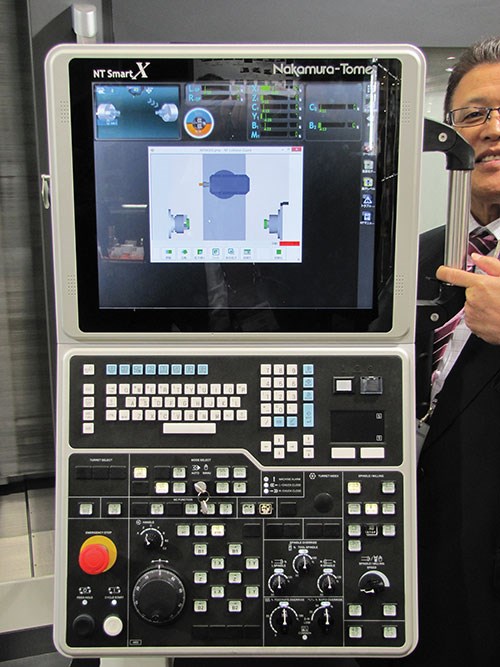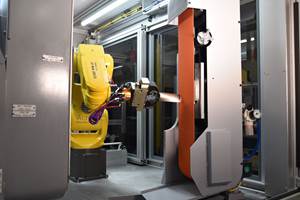2014 JIMTOF Report: Machining Added to Additive
JIMTOF Report: Machining Added to Additive
Adding an additive manufacturing process to a machining center is interesting. Adding machining to an additive manufacturing machine is also interesting. Both developments show that additive and machining processes can supplement and complement one another.
Interest in additive manufacturing was high at JIMTOF 2014, as it has been at recent manufacturing technology shows, especially IMTS this past September in Chicago. The show in Japan (October 30-November 4) marked the appearance of several hybrid additive/machining combinations of both varieties mentioned above.
Mazak introduced its i400AM Integrex, which incorporates a rough and finish laser cladding capability as an extension of its multitasking concept. Separate laser heads are stored in the tool magazine for these operations. Likewise, DMG MORI displayed the Lasertec 65, which also features an integrated metal laser cladding system.
Having the additive process on board enables these machines to build up new surfaces or features such as ribs, tubular extensions, fan blades, flanges and more. It is possible to generate these new features in a material that is harder or lighter than the parent workpiece material. Once built up, these features can be milled in five axes, turned, contoured or otherwise machined before removing the part in a completely manufactured state (done-in-one).
Two notable machines on display at the show demonstrated the value of adding a milling process to a laser sintering machine. The Matsuura Lumex Avance-25 integrates a fiber laser for sintering layers of metal powder with a high-speed milling process that contours a number of successive layers of sintered material. The milling leaves a surface that is smooth and accurate, requiring no subsequent finishing. The applications in focus at JIMTOF were mold components with complex internal cooling channels and deep, thin ribs. (This machine is marketed in the United States by MC Machinery Systems Inc.)
Sodick’s new metal 3D printer, the OPM250L, is a very similar hybrid laser sintering/high-speed milling machine. Reportedly, this machine can fabricate nine mold inserts in around 24 hours. The milling spindle has a top speed of 45,000 rpm.
Kitamura’s “reverse 3D printing” process deserves a note in this context as well. Although this capability does not include 3D printing, this builder has developed a directly integrated software program that interfaces between a scanner and the machine control. After scanning a 3D model with the scanner connected to the machine, the software converts the scanned points so the machine can cut the 3D object from solid material. This process is the focus of Kitamura’s XrossCut VMC, which uses two parallel X axes, one moving the spindle and one moving the table. While feeding one of these components in the plus direction and simultaneously feeding the other in the negative direction, cutting rates can exceed 9,000 ipm in aluminum, plastic or other soft materials.
Of course, additive manufacturing was not the only highlight of this JIMTOF. Another significant trend noted was reshaping CNC units into large, flat panels with oversized high-definition display screens. New operating systems clearly copy the features and functions of the smartphone. Touchscreen navigation, customizable displays, hot-button shortcuts and easy networking make these CNCs appealing to the “connected” generation of young professionals in manufacturing.
In addition, JIMTOF confirmed other leading trends in machine tool design and capability. Multitasking capability continues to expand the operations it includes and the range of travel for integrated B, Y and other add-on axes. Likewise, few builders active in the milling arena do not offer five-axis capability now. Gear-making technology is also on the move, especially in highly productive skiving operations. Machines and cutting tools designed to handle titanium and other tough materials were also very much in evidence.
The next show in 2016 promises to fill expanded exhibit space at the Tokyo Big Sight conference and exhibition center, as well as offer its traditional emphasis on the advanced engineering that underlies Japan’s position as a leading source of manufacturing technology.
Related Content
Aircraft Engine MRO: How Additive Manufacturing Plus Robotic Finishing Will Expand Capacity for Blade Repair
AM offers the chance to bring fast, automated processing to individualized, part-by-part restoration of turbomachinery. A cell developed by Acme Manufacturing and Optomec is able to automatically repair 85,000 unique aircraft engine blades per year.
Read MoreVulcanForms Is Forging a New Model for Large-Scale Production (and It's More Than 3D Printing)
The MIT spinout leverages proprietary high-power laser powder bed fusion alongside machining in the context of digitized, cost-effective and “maniacally focused” production.
Read MoreDMG MORI: Build Plate “Pucks” Cut Postprocessing Time by 80%
For spinal implants and other small 3D printed parts made through laser powder bed fusion, separate clampable units resting within the build plate provide for easy transfer to a CNC lathe.
Read More8 Cool Parts From Formnext 2023: The Cool Parts Show #65
New additive manufacturing technologies on display at Formnext were in many cases producing notable end-use components. Here are some of the coolest parts we found at this year’s show.
Read MoreRead Next
3D Printing Brings Sustainability, Accessibility to Glass Manufacturing
Australian startup Maple Glass Printing has developed a process for extruding glass into artwork, lab implements and architectural elements. Along the way, the company has also found more efficient ways of recycling this material.
Read More













.png;maxWidth=300;quality=90)








